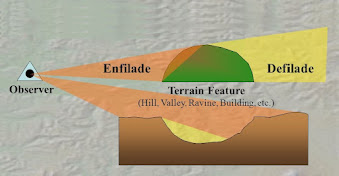Defilade (pronounced def-uh-leyd or def-fuh-lahd)
(1) In military tactical planning and battlefield
practice, the protection from hostile ground observation and flat projecting
fire provided by an artificial or natural obstacle such as a hill.
(2) The disposition of defensive fortifications
to produce this protection.
(3) A fortification having such protection.
1828: From the French défil (to unthread), the construct being dé (remove) + filer (thread), from the Latin fīlum (thread). The -ade suffix was a borrowing of the Spanish -ado, from the Latin -ata (feminine -atum) used to create adjectives, nouns, and sometimes verbs from words ending in -a. The suffix was used to form nouns denoting action, or a person performing said action. The Old French verb was borrowed by Middle English as défiler (to slip away or off), use apparently restricted to the nobility. The related forms are defiladed & defilading.
Enfilade
(pronounced en-fuh-leyd or en-fuh-lahd)
(1) In military tactical planning and battlefield practice, a position of works, troops and matériel which permits sweeping fire from along the length of a line of troops, a trench, a battery etc.
(2) The fire thus directed.
(3) In architecture, an axial arrangement of
doorways connecting a suite of rooms with a vista extending the entire length
of the suite.
(4) In interior decorating, an axial arrangement
of mirrors on opposite sides of a room so as to give an effect of an infinitely
long vista.
1697: From the French enfil (to thread), the construct being, en (put on) + filer
(thread), from the Latin fīlum
(thread). The -ade
suffix was a borrowing of the Spanish -ado,
from the Latin -ata (feminine -atum) used to create adjectives, nouns,
and sometimes verbs from words ending in -a.
The suffix was used to form nouns denoting action, or a person
performing said action. The Old
French verb was borrowed by Middle English as enfile (to put (something) on a thread or string), use apparently
restricted to the nobility.
The use in architecture (mostly to describe rows
of apartments) and forestry (referencing rows of trees) predated the military
sense which now predominates, the original definition in that context printed
in military manuals as “rake with shot through the full length”. The use in architecture persists though it’s
long tended to be used loosely to refer to just about anything in a straight
line. Used as a verb since 1706, the
related forms are enfiladed & enfilading.
NATO defines the parameters of the defilade as
(1) protection from hostile observation and fire provided by an obstacle such
as a hill, ridge, or bank, (2) a vertical distance by which a position is
concealed from enemy observation and (3), to shield from enemy fire or
observation by using natural or artificial obstacles. However, the standard definition reflects the
origin of the concept in the pre-mechanical age. In anti-tank (or other armored vehicle)
operations, it can be advantageous to generate enfilade fire with anti-armor
weapons, from a defilade position, armor tending to be weaker on the sides and
rear of armored vehicles so side shots (enfilade) offer greater penetrative
potential.
The practical employment of the defilade position
need not require construction and may be achieved by taking advantage of a favorable feature of the natural environment such as a ditch, the tactical
significance being the enemy is engaged not from the front but from the flank
using enfilade fire, the font being protected with hard cover. Used thus, ground
to the front will be covered by mutually supporting positions firing from
defilade, both sides firing across the front.

No comments:
Post a Comment